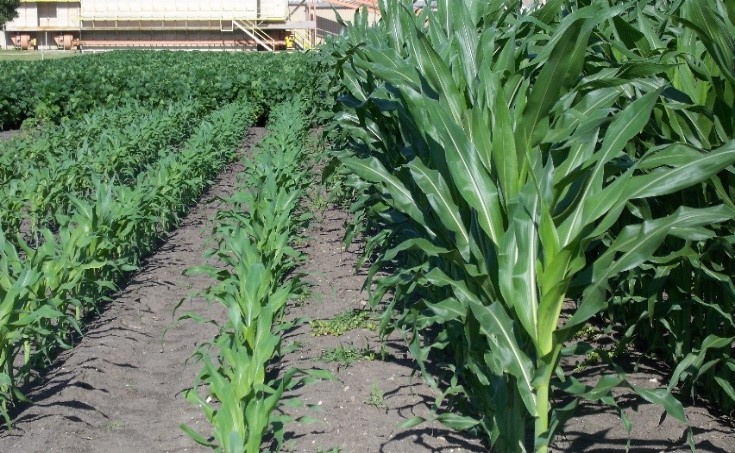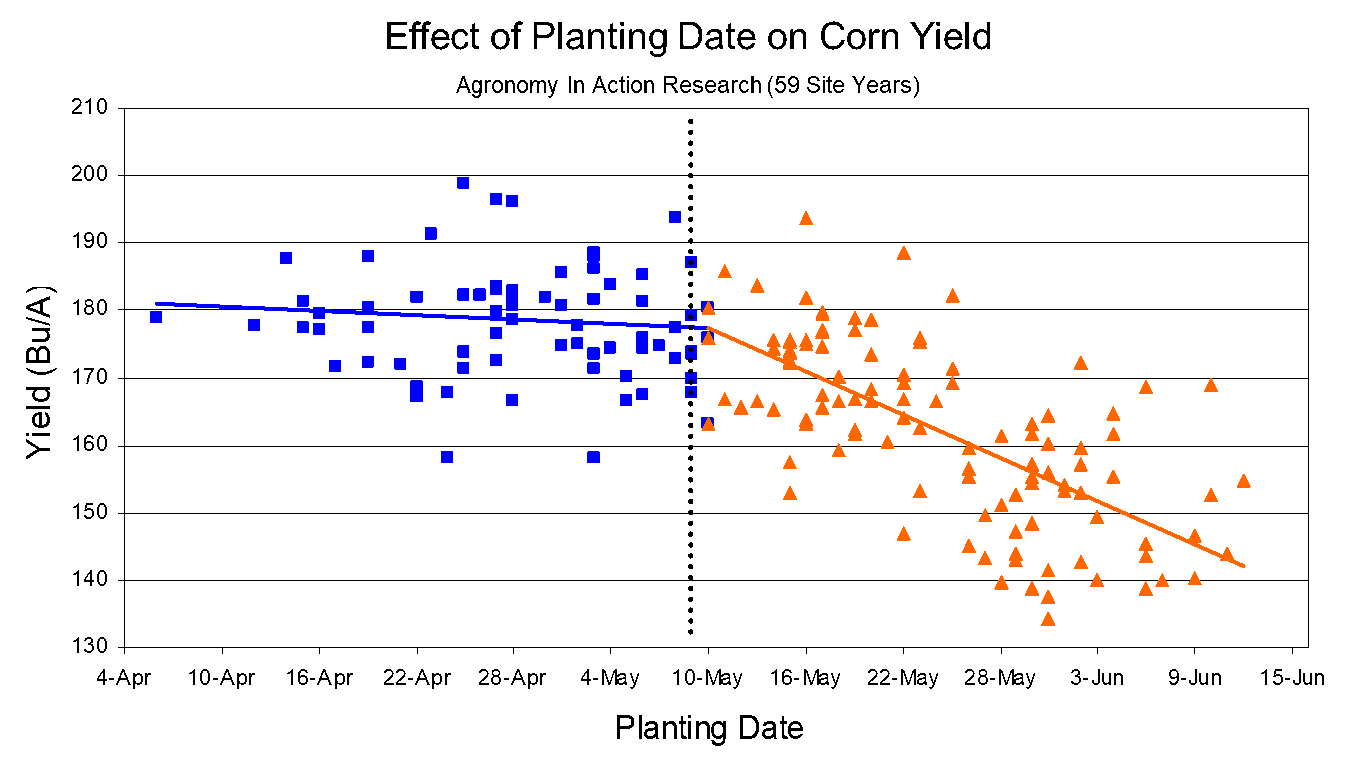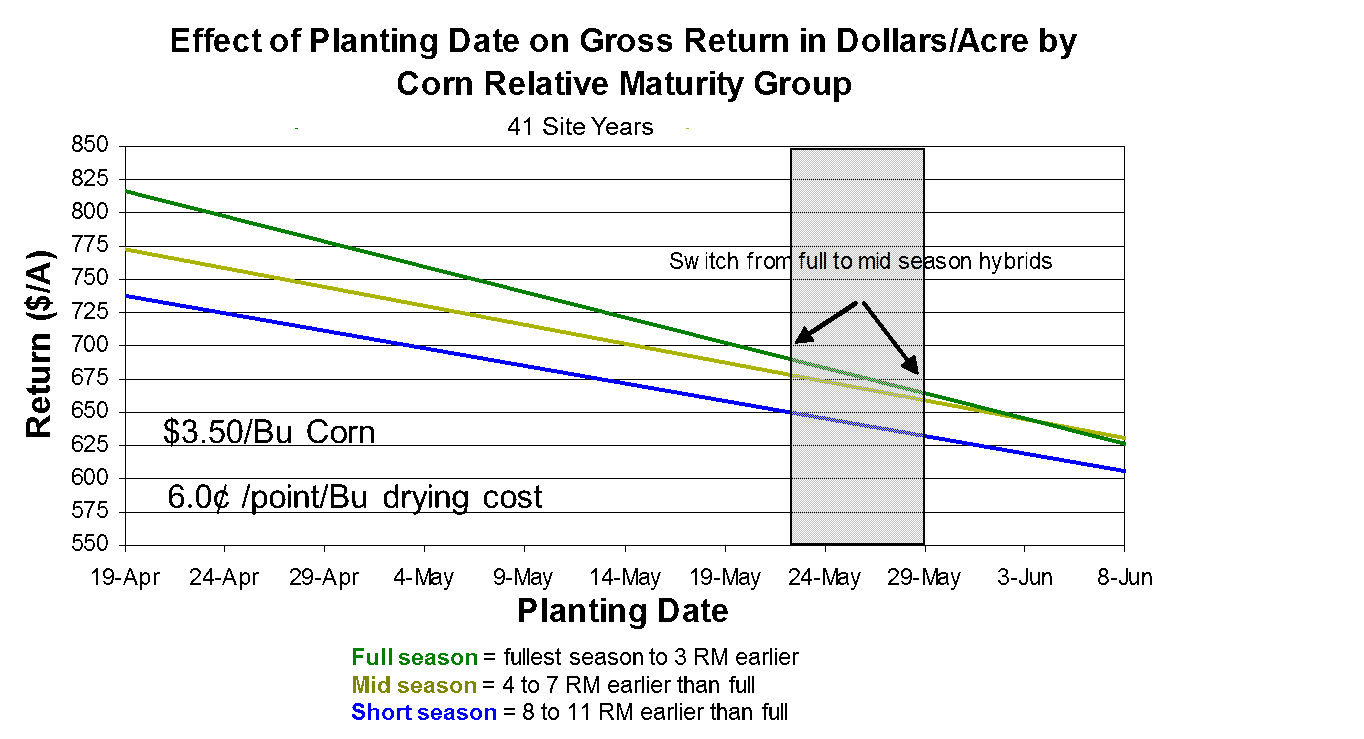Every soybean producer in Illinois is also a corn producer. And one of the commonalities about farming in Illinois is that sometimes it will rain in the spring and delay or prevent planting. There comes a point in time that growers must decide whether to switch maturities or even switch crops (switching from corn to soybeans). There are several things to consider in that decision and the most likely is which will be most profitable.
 On average, hybrids will only lose one bushel for every 10 days of planting delay prior to May 10th.
On average, hybrids will only lose one bushel for every 10 days of planting delay prior to May 10th.- Planting dates after May 10th can experience up to 1 bu/day of delay yield loss.
- Yield benefits of full season hybrids offset potential grain drying cost enough to discourage switching RM prior to last week of May.
- Corn hybrids mature with fewer accumulated heat units when planting is delayed, minimizing the risk of fall frost injury.
Historical research and numerous university

trials have shown that there is minimal (0.11 bu/day) yield loss from delayed planting up until May 10th. After May 10th there is a much bigger penalty (1 bu/day) for delayed planting. The thought of switching to an earlier maturity hybrid as result of planting delay happens more frequently than most corn producers would like to think about. Thoughts of an early fall frost start to make the decision more emotional. Before shifting to an earlier maturity hybrid, understanding the research available will help you make the most profitable decision.
A slight delay in planting doesn’t necessarily translate into the need to switch to a shorter Relative Maturity (RM) hybrid. It is well understood that corn hybrids mature with fewer accumulated heat units when planting is delayed (Brown, 1999; Nielsen et al, 2002). This allows the same RM hybrid to reach physiological maturity in fewer days than earlier planting dates, reducing the risk of delayed maturity and potential frost injury. There still may be a need to switch to an earlier RM hybrid at some point in time, however it’s important to remember that a day delay in planting does not mean a day delay in harvest.
Golden Harvest Agronomy in Action research conducted multi-year studies to better understand the financial impact associated with switching to an earlier RM hybrid too quickly. Assumptions of $3.50 per bushel and $0.06 per point drying costs along with yield data from planting date trials were used to calculate $/A return for full (green line), mid (yellow line) and short (blue line) season hybrids adapted for the area.

Full season hybrids were defined as an RM ranging from fullest acceptable for an area to minus 3 RM. Mid-season hybrids were 4-7 RM earlier than the full season hybrids and short season hybrids were 8-11 RM earlier than full season hybrids. In over 41 trials, the yield benefits of planting a full season hybrid outweighed the cost associated with higher moisture grain with drying costs at harvest for planting dates up to the end of May.
Considering moving 4-7 RM earlier at the 1st of June could be warranted. Aggressive RM changes of 8 or more RM may result in drier grain. However, less yield potential of earlier RM hybrids will result in lower profit than drying a fuller season hybrid. University recommendations for most Midwestern corn producing states such as
Michigan State University,
University of Minnesota,
Iowa State University and
University of Wisconsin support waiting until May 20 to May 30 before switching to earlier RM hybrids.
There are many reasons to consider switching to an earlier RM hybrid that also need to be considered. Lack of access to grain drying capabilities (bushels per hour), grain contract delivery dates and harvest capacity (acres per day) are just a few reasons to consider switching earlier. If these factors are not a concern you may have an opportunity to maximize your profit potential by sticking to your original hybrid selection.
 On average, hybrids will only lose one bushel for every 10 days of planting delay prior to May 10th.
On average, hybrids will only lose one bushel for every 10 days of planting delay prior to May 10th. trials have shown that there is minimal (0.11 bu/day) yield loss from delayed planting up until May 10th. After May 10th there is a much bigger penalty (1 bu/day) for delayed planting. The thought of switching to an earlier maturity hybrid as result of planting delay happens more frequently than most corn producers would like to think about. Thoughts of an early fall frost start to make the decision more emotional. Before shifting to an earlier maturity hybrid, understanding the research available will help you make the most profitable decision.
trials have shown that there is minimal (0.11 bu/day) yield loss from delayed planting up until May 10th. After May 10th there is a much bigger penalty (1 bu/day) for delayed planting. The thought of switching to an earlier maturity hybrid as result of planting delay happens more frequently than most corn producers would like to think about. Thoughts of an early fall frost start to make the decision more emotional. Before shifting to an earlier maturity hybrid, understanding the research available will help you make the most profitable decision. Full season hybrids were defined as an RM ranging from fullest acceptable for an area to minus 3 RM. Mid-season hybrids were 4-7 RM earlier than the full season hybrids and short season hybrids were 8-11 RM earlier than full season hybrids. In over 41 trials, the yield benefits of planting a full season hybrid outweighed the cost associated with higher moisture grain with drying costs at harvest for planting dates up to the end of May.
Full season hybrids were defined as an RM ranging from fullest acceptable for an area to minus 3 RM. Mid-season hybrids were 4-7 RM earlier than the full season hybrids and short season hybrids were 8-11 RM earlier than full season hybrids. In over 41 trials, the yield benefits of planting a full season hybrid outweighed the cost associated with higher moisture grain with drying costs at harvest for planting dates up to the end of May.

 and then
and then